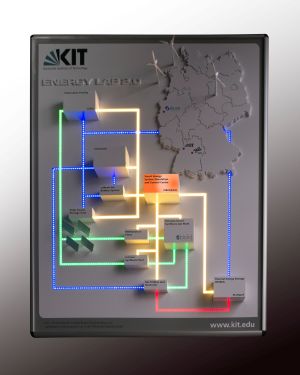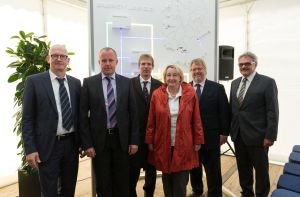The Energy Lab 2.0 at Karlsruhe Institute of Technology (KIT) is a smart platform to analyze the interaction of components of future energy systems. Today, the project associated with an investment of EUR 22 million was started officially. The Energy Lab 2.0 aims at an acceleration of the Energiewende and in particular the integration of renewable energies in electricity production. It can be used to test closely to reality new approaches to stabilizing power grids. The platform pools electric, thermal, and chemical energy flows as well as new information and communciation technologies. Project partners are the German Aerospace Center (DLR) and Forschungszentrum Jülich (FZJ), both members of the Helmholtz Association. The Energy Lab 2.0 is financed by the Federal Republic of Germany and the state of Baden-Württemberg.
“The Energiewende is a central topic of relevance to the future in Germany, it is a big challenge for research and industry. For the Energiewende, the transformation of the energy system, to succeed, appropriate and reliable storage technologies, a smart extension of the grid, and securing of grid stability are of crucial importance. On the way towards electricity supply based on renewable energy sources, the Energy Lab 2.0 will make essential contributions. The Energy Lab 2.0 and in particular its simulation environment will help us advance the scientific use of big data and digitization,” comments Theresia Bauer, Baden-Württemberg Minister of Science, Research, and the Arts.
“The Energy Lab 2.0 will be a unique infrastructure facility in Europe to support Germany in the development of options for transforming the energy system. The Energy Lab 2.0 will allow for the testing of new approaches to stabilizing power grids. It is our objective to further strengthen Germany as a location of research and to further extend our leadership in next-generation technologies in the energy sector in particular. Germany’s research institutions already are much sought-after partners for issues relating to energy. The institutions involved in the Energy Lab 2.0 project, namely, Karlsruhe Institute of Technology, the German Aerospace Center, and Forschungszentrum Jülich, are among the biggest energy research centers in Europe and flagships of Germany as a location of energy research,” says the Undersecretary of State of the Federal Ministry of Education and Research, Dr. Georg Schütte.
“To support the transformation of the energy system in Germany, our clear priorities lie on renewable energy sources, energy storage systems, and grid technologies,” says KIT President Professor Holger Hanselka, who also is the Research Field Coordinator Energy of the Helmholtz Association. “Integrating energy from fluctuating renewable sources, such as the sun and the wind, into the grid and ensuring the required security of supply are among the biggest challenges we face. The findings made in the Energy Lab 2.0 will provide major indications as to how future power grids in Germany may be designed.”
“Transformation of the energy system requires the establishment of new technologies to convert renewable electricity into other energy carriers, such as hydrogen,” explains Professor Harald Bolt, Member of the Board of Directors of Forschungszentrum Jülich. “This “green” hydrogen can be used in mobility and industry and also be reconverted into electricity. Forschungszentrum Jülich contributes its competence relating to hydrogen technologies and their integration into the energy system to the Energy Lab 2.0.”
“The future energy system requires a much more flexible operation of power plants,” emphasizes Professor Manfred Aigner, Director of the DLR Institute of Combustion Technology. “This is a central challenge of the Energiewende. For this reason, the DLR develops a combustion system for gas turbine power plants, which allows for quick load cycling and the efficient and environmentally compatible use of various fuels, from natural gas to hydrogen. At the same time, the DLR contributes its expertise in the area of thermal energy storage for further flexibilization of operation to the Energy Lab,” Aigner continues.
“The problem of supplying efficient, sustainable, and secure power grids for the wide use of renewable energy sources is far from being solved,” Professor Jürgen Mlynek, President of the Helmholtz Association, says. “For the first time in Europe, the Energy Lab 2.0 will combine larger test facilities for electricity production, energy storage, and energy use in order to develop a smart system for energy supply. Pooling of expertise of various Helmholtz Centers once again shows how necessary interdisciplinary scientific cooperation is,” Mlynek adds.
The Energy Lab 2.0
The project is embedded in the overall energy strategy of the Helmholtz Association. For the Energy Lab 2.0, the partners plan to build a simulation and control center and a network of energy technology facilities on KIT Campus North, an electrolysis test center at Forschungszentrum Jülich, and a facility for testing power-to-heat concepts at the German Aerospace Center, Stuttgart, by 2018.
The energy platform will link characteristic components for power, heat, and synthesis gas production with various energy storage technologies and consumers. For this purpose, large facilities existing at KIT will be integrated into the Energy Lab 2.0: The solar power storage park, the bioliq pilot facility, and selected energy consumers on KIT Campus North. Electrical, electrochemical, and chemical storage systems as well as a load- and fuel-flexible gas turbine with current generator will be newly constructed and are planned to complement the network. A simulation and control center at KIT will integrate all network components of KIT and the partners in a smart energy system using information and communication technologies. This infrastructure facility is the first of its type in Europe.
In the long term, additional external test facilities and, in cooperation with industry, also large external components of the energy system, such as wind parks, geothermal facilities, conventional power plants, and large industrial consumers, can be integrated into the Energy Lab 2.0.
Stepwise Development and Validation
Under the Energy Lab 2.0 project, scientists will first develop model tools and approaches to grid stabilization. For this purpose, an experimentation field with all relevant system components on a smaller scale and a test field for electric grid components with real-time simulation will be used. Subsequent validation will take place on the network level. Based on the results, real energy systems will be simulated in a third step and analyzed for e.g. grid stability. The project is managed by Professor Roland Dittmeyer, Head of the KIT Institute for Micro Process Engineering (IMVT).
Of the total investment in the amount of EUR 22 million, 16.75 milion will be invested at KIT. The Helmholtz Association funds the Energy Lab 2.0 with a total of EUR 15 million. Three million are provided by the state of Baden-Württemberg. The Federal Ministry of Education and Research (BMBF) supports the project with an additional amount of EUR 2.5 million, the share of the Federal Ministry for Economic Affairs and Energy (BMWi) is EUR 1.5 million. The Energy Lab 2.0 is scheduled for an operation duration of 20 years.

Model of the Energy Lab 2.0. (Photo: Markus Breig)
Photo 1: Model of the Energy Lab 2.0. (Photo: Markus Breig, KIT)
Photo 2: Professor Roland Dittmeyer (KIT), Dr. Bernd Emonts (FZJ), Professor Holger Hanselka (President of KIT), Theresia Bauer (Minister of Science, Research, and the Arts of Baden-Württemberg), Dr. Herbert Zeisel (Section Head, Federal Ministry of Education and Research), Professor Manfred Aigner (DLR) (from left to right. Photo: Patrick Langer, KIT)
Photo 3: The solar power storage park at KIT is part of the Energy Lab 2.0. (Photo: Patrick Langer, KIT)
Photo 4: Theresia Bauer (Baden-Württemberg Minister of Science, Research, and the Arts) in front of the model of the Energy Lab 2.0. (Photo: Patrick Langer, KIT)
Photo 5: Head of the Energy Lab 2.0 project, Professor Roland Dittmeyer. (Photo: Patrick Langer, KIT)
Photo 6: President of KIT: Professor Holger Hanselka. (Photo: Patrick Langer, KIT)
Photo 7: Theresia Bauer (Baden-Württemberg Minister of Science, Research, and the Arts). (Photo: Patrick Langer, KIT)
Photo 8: DLR’s high-temperature storage system HOTREG for thermal energy storage is digitally integrated into the Energy Lab 2.0. The high-temperature heat stored in the system can either be used to supply process heat or for conversion into electrical power. (Photo: DLR/Ernsting)
In close partnership with society, KIT develops solutions for urgent challenges – from climate change, energy transition and sustainable use of natural resources to artificial intelligence, sovereignty and an aging population. As The University in the Helmholtz Association, KIT unites scientific excellence from insight to application-driven research under one roof – and is thus in a unique position to drive this transformation. As a University of Excellence, KIT offers its more than 10,000 employees and 22,800 students outstanding opportunities to shape a sustainable and resilient future. KIT – Science for Impact.

